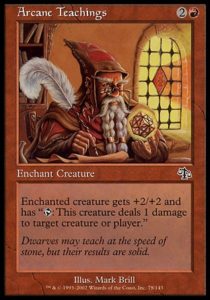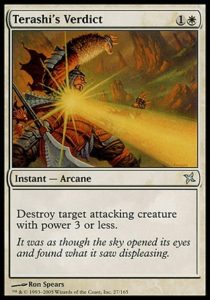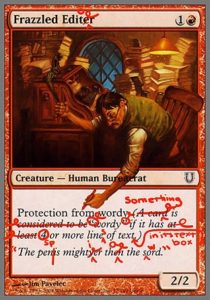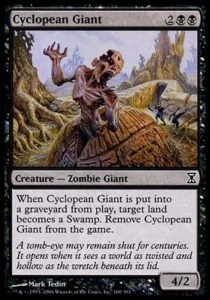Dominaria is the first set of the blockless paradigm. It’s the first set to be designed with a Play Design team. It’s the first revisiting of Dominaria since Magic fully embraced that it’s a game about traveling to a variety of high concept, revisitable worlds. It follows in the footsteps of underwhelming large sets like Ixalan and Battle for Zendikar and a turbulent Standard era. There are a host of things the set needed to accomplish, pitfalls it could have fallen victim to, baggage it had to update or discard, and design paradigms it had to decide whether to follow or buck. I can’t think of a set rife with so many uncertainties and expectations.
And Dominaria delivered. The set is a masterpiece.
Today, rather than merely kvell about enjoying the format, let’s ask the more important question: why? What factors make Dominaria so good?
What Makes a Good Limited format?
A couple years ago, I posited that there are six criteria for evaluating Limited formats:
Balance—how wide the power disparity is across different colors, color combinations, and archetypes. A more balanced format has more viable decks; a less balanced format has fewer options.
Power—what percentage of cards at each rarity are excellent, decent, and awful. A more powerful format has a ton of swingy cards (such as Mist Raven in Avacyn Restored or the plethora of bomb rares in Fate Reforged); a less powerful format has fewer cards able to take over the game (and oftentimes, but not always, more unplayable commons).
Synergy—whether players are encouraged to draft archetypes (where a card’s value is determined by what other cards it interacts with) or ‘good stuff’ (where cards behave and are valued similarly across color combinations). Lorwyn and Modern Masters 2013 are very high synergy formats, Innistrad is a medium-high synergy format, and most core sets are low synergy formats (though Magic Origins bucked this trend).
Replayability—a measure of how long it takes for a format to become stale. The more replayable the format, the longer it will take to master and the longer it will hold player interest. This can be due to a host of factors, but it depends heavily on balance: if there are only a few viable archetypes, color combinations, or shenanigans, it doesn’t take long for you to see everything a format was capable of. Ixalan really suffered in this regard.
Fixing—how easy it is to play more than two colors. Most formats nowadays have some fixing at common (usually in green, a land like Evolving Wilds or Unknown Shores, and possibly an artifact) and oftentimes an uncommon dual land cycle. High-fixing formats like Khans of Tarkir and artifact-heavy formats like Aether Revolt enable 3-5 color decks; fixing-light formats like Shadowmoor and Theros actively encourage monocolor decks.
Interaction—how easy it is to interact with your opponent’s stuff. This is almost always creature removal, but in sets like Mirrodin or Theros, Naturalize effects also apply. This is both a measure of the quantity of common removal as well as its quality (relative to the power level of the average threat). Interaction-heavy formats like Magic 2011 often devolve into card advantage battles; interaction-light formats like Avacyn Restored, Amonkhet, and Ixalan devolve into races.
How does Dominaria stack up?
Balance. Dominaria definitely isn’t perfectly color-balanced (especially not in sealed). Red is likely by far the worst color, but it’s hardly unplayable. White is mostly doing its own thing (making it either amazing or terrible, based on your preferences). However, there are no glaring color issues as there were in Innistrad or Battle for Zendikar. Dominaria’s archetypes and colors are fairly balanced.
Power. The average power level of a common is quite low, whereas the average power level of many uncommons and rares is through the roof. Folks will be able to play with sweet cards more often (since there are uncommon bombs) and with both greater variety and time to deploy said cards (because there are few commons that take over the game). Nevertheless, there is enough power at common for aggressive decks to punish super durdley decks, preventing the format from degenerating into pure card advantage wars. This is fertile ground for a solid format.
Synergy. Synergy in Dominaria is widespread and relatively weak. There are a ton of minute interactions, some tribal (wizards, saprolings), some A+B (historic and legend-matters), and many, many more specific interactions (Tragic Poet or Nature’s Spiral plus sagas, Homarid Explorer with Garna, the Bloodflame). There are tons of shenanigans for folks who want to find them, but they’re not so powerful or consistent that the format is on rails, as Ixalan and Lorwyn were. Dominaria is an excellent synergistic format, albeit an incredibly complex one.
Replayability. Thanks to Dominaria’s multitudinous synergies, low power level at common, and breadth of uncommon bombs, there is seemingly endless discoveries and combinations to crafted. This format is one for the ages.
Fixing. Dominaria has unusually weak fixing. Skittering Surveyor is a godsend, as is Grow from the Ashes, but that’s about it. Navigator’s Compass makes one long for the days of Painted Bluffs. The dearth of fixing is almost certainly by design, however: if it were easy to play many colors and all the bombs, everyone would. While I certainly enjoy formats which enable greed more, I recognize that ample fixing would be too dangerous here. Well done, R&D.
Interaction. Interaction has been getting weaker relative to threats (particularly in large sets) for quite some time now. Dominaria bucks this trend by having a large quantity of common removal, some of which is top quality, and a smaller quantity of must-answer common creatures. While removal is still much weaker than it used to be, there is a real (and deserved) risk for playing cards like Dub and Arcane Flight where previously there hadn’t been. The format is defined less by unanswerable cards and more by being patient enough to deploy your removal only when you must. This is a much more interesting and satisfying game than the, “One With the Wind, someone loses right now” game.
The Verdict
Dominaria performs extremely well across all our metrics. It does a ton of things right, so many so that it rightfully is discussed as possibly one of the greatest formats of all time. However, it’s certainly not a perfect set. It possesses a contentious quality that belongs on the list: complexity.
Dominaria has very high complexity across all rarities. Some of this lenticular complexity (so it’s hidden from less experienced players), but much of it is tiny, forgettable lines of text. Thallid Omnivore, Juggernaut, Knight of Malice, Academy Journeymage, and D’Avenant Trapper are all perfectly fine cards in and of themselves with neat abilities, but they all care about very specific things that few other cards care about (and care about in the same way). Slinn Voda, the Rising Deep feels like it should bounce everything, but in the name of flavor it doesn’t (so it doesn’t perform the way everyone intuitively expects it to, even when they read the card). Garna, the Bloodflame has three very different abilities and does two of them in weird ways (most things grant haste to themselves as well, and few cards recur creatures put into the graveyard from anywhere in a particular turn), Tiana, Ship’s Caretaker plays into the aura/equipment micro-theme in a forgettable way that’s relevant in a fraction of games and so often not remembered. All of these cards individually aren’t problematic, but there are an enormous number of cards with forgettable and often unique text, making it harder to remember what every card does precisely.
There is probably far too much complexity in Dominaria, and while this appeals to many (and gives the format its rich synergies and opportunities for discovery), it’s a dangerous quality for Magic to possess too much of.
Properly executing nostalgia
Finally, let’s talk about execution and history. Dominaria is now History World, where Magic’s rich history is infused into everything. We’ve seen this before in the divisive Time Spiral block, and it was handled quite differently.
Time Spiral was a deep Limited format full of history for the enfranchised player, a love letter to Magic’s rich history. That history was mostly opaque to folks who weren’t around for all of it, and the set was overstuffed with mechanics (almost as many as had ever existed in Magic to that point). Its sense of history is perhaps best exemplified in Cyclopean Giant—this card is an in-joke, an obscure reference to two cards from ’93: Cyclopean Tomb and Cyclopean Mummy (technically two of them stapled together). Time Spiral was probably a lot like starting Game of Thrones on season four—a whole bunch of stuff is happening, but you lack the context for it to have impact.
Dominaria, on the other hand, is about hitting major themes—there are Benalish knights with (brand new) stained glass motifs! There are high fantasy creatures like pegasi and unicorns and an evil cabal named the Cabal. Rather than hide its history in mechanical designs, Dominaria exposes it in broad strokes. There are mechanical nods for the enfranchised player like the odd kavu, thrull, and djinn, but the set does a much better job of inviting players of all ages and experiences to enjoy a world of history than to play “Get the Reference?” That’s a lot more fun for everyone.
And that’s Dominaria in a nutshell. An excellent execution on Magic’s past and Limited present. Dominaria hasn’t gotten old yet and I look forward to discovering even more of its secrets as I prepare for GP DC. And as always, thanks for reading!
Zachary Barash is a New York City-based game designer. He works for Kingdom Death: Monster, has a Game Design MFA from the NYU Game Center, and does freelance game design. When the stars align, he streams Magic.
His favorite card of the month is Ghitu Chronicler. For two mana less than Archaeomancer, you get Straw Soldiers. For two mana more, you get an Archaeomancer with one extra point of toughness. Somehow, the combination of these two components yields a more powerful card than the more straightforward one. It all goes to show how powerful flexibility and Kicker are. …unless you’re playing Ghostly Flicker, then everything I just said is wrong.





